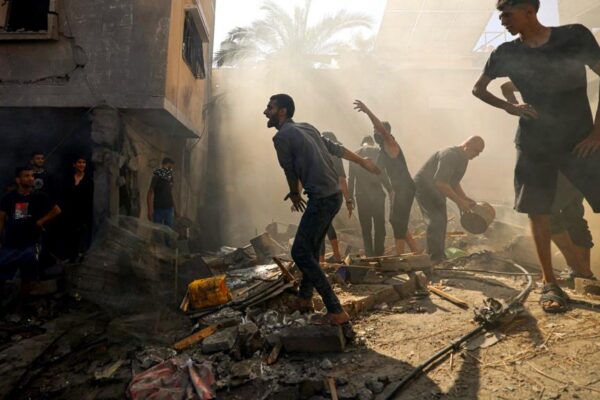“It will take tens of billions of dollars and several decades to repair the unprecedented destruction in Gaza.”
“It will take tens of billions of dollars and several decades to repair the unprecedented destruction in Gaza.”
According to UNEP, Israel’s war on Gaza has not only been a disaster in terms of lost human lives, but the nine-month-led crisis has also impacted Gaza’s civil infrastructure.
Israel’s bombing of Gaza has generated 39 million tonnes of military debris and hazardous material, including human remains and bombs, which will persist in Gaza’s environment and affect its residents, based on a preliminary assessment released by the UN Environment Programme (UNEP) on 18 June 2024.
“Not only are the people of Gaza dealing with untold suffering from the ongoing war, the significant and growing environmental damage in Gaza risks locking its people into a painful, long recovery. While many questions remain regarding the exact type and quantity of contaminants affecting the environment in Gaza, people are already living with the consequences of conflict-related damage to environmental management systems and pollution today. Water and sanitation have collapsed. Critical infrastructure continues to be decimated. Coastal areas, soil and ecosystems have been severely impacted. All of this is deeply harming people’s health, food security and Gaza’s resilience,” said Inger Andersen, UNEP Executive Director.
Israel’s war on Gaza has been raging for over 200 days now.
Since 7 October, over 38,000 Palestinians have been killed by Israel, according to the Palestinian health ministry.
Israel’s bombing of Gaza also has disastrous consequences for ecosystems and violates the right of many people to live in a healthy environment.
Astrid Puentes, the new UN Special Rapporteur on human rights and the environment, told the Guardian, “One of the serious consequences of the war in Gaza has been the massive violation of the right to a clean, healthy and sustainable environment … which represents a serious risk to life and the enjoyment of all other rights”.
The ongoing Israel’s onslaught on Gaza has caused severe damage to the environment, with consequences for air, water and land, as well as for Gaza’s population.
Carbon emissions caused by the war are staggering. A new study from Queen Mary University of London has found out that Israel’s war on Gaza generated 536,410 tons of carbon dioxide during the first 120 days of the war, including 90% attributed to aerial bombardments and the Israeli ground invasion of Gaza, which “exceeded the annual emissions of 26 individual countries.”
The air in Gaza is contaminated with chemicals from weapons, such as white phosphorus, due to the extensive use of explosives.
Exposure to white phosphorus munitions causes decreased productivity of agricultural land and can harm plants.
Arable land has also suffered significant losses since October 2023, and under Israel’s control, cultivable land has diminished as well.
Indeed, when comparing the area of agricultural land in recent years with recent satellite images, the UN documented the alarming and considerable decline of approximately 46.2% of cultivated land as of 15 February.
Sheep and dairy farms were seriously affected, while 339 hectares of greenhouses were destroyed.
Last January, the agricultural area amounted to 17,800 hectares, or about half of the total area of Gaza, according to the UN satellite centre UNOSAT.
The damage in Deir al-Balah and Khan Younes increased in just one month.
These thousands of hectares of agricultural land outside densely populated cities, such as Gaza and Khan Yunis, are usually a key source of food and income for Palestinians.
Around 2.5 million fruit trees were uprooted from 1967 to 2007 in the Gaza Strip and the West Bank, according to the Palestinian NGO Applied Research Institute – Jerusalem, a third being olive trees.
Olive trees, which are essential in Palestine due to their deep cultural significance and economic importance and which support the livelihood of many families through the production of olive oil, have been regularly and deliberately targeted by the Israeli military and settlers.
They have thus become the symbol of the suffering of Palestinians dispossessed of their heritage and prevented from having access to their land and their crops.
The destruction of olive trees is part of a more general context of degradation of land and property – particularly in the West Bank – and restrictions with significant consequences for the livelihoods, food security and environment of Palestinians.
The destruction of farms and agricultural land, combined with 17 years of blockade that deprived the region of essential farm inputs, has caused severe food insecurity.
Since May 2024, 57% of cultivated land in Gaza has suffered damage. Furthermore, Israel has destroyed 70% of Gaza’s fishing fleet, according to the United Nations.
Livestock are starving and unable to provide food or a food source for Palestinians in the Gaza Strip.
Water is used as a weapon by Israel in Gaza
Water resources have been severely compromised, with almost 60,000 cubic meters of untreated sewage flowing into the Mediterranean Sea daily.
Gaza’s drinking water network, already failing before the war with 90 to 95% of non-drinkable groundwater, is currently in an even more critical situation.
As of April 2024, Gaza residents had access to 2 to 8 litres per person per day on average, compared to 85 litres per person per day before October 2023.
Research reveals that 20 litres per person per day represent the minimum quantity of safe water necessary to ensure the minimum levels essential for health and hygiene.
Climate change is a silent killer in Gaza
Temperatures in the Middle East and North Africa region are warming almost twice as fast as the global average.
Gaza, which is already a climatically vulnerable region, is facing deteriorating conditions due to the war.
Forecasts estimate that temperatures could rise by 4°C by the end of the century, amplifying erratic precipitation, heat waves and droughts.
Public health infrastructures, already weakened by years of blockade, are collapsing under the pressure of the war.
Sewerage, wastewater and solid waste management systems and facilities have collapsed.
The spread of diseases such as skin infections, hepatitis A and diarrhoea is increasing, and a potential outbreak threatens thousands of lives.
Attacks on hospitals and blockages of medical supplies have crippled Gaza’s health system, leaving millions of people in urgent need of humanitarian aid.
Over the past eight months, attacks on hospitals, ambulances and health workers have become systematic.
According to the UN Office for the Coordination of Humanitarian Affairs (OCHA), between 7 October and 27 May, 493 health workers were killed in the Gaza Strip.
Local health authorities also reported that 126 ambulances were affected. According to OCHA, only 16 of the 36 hospitals in the Gaza Strip are still partially functional.
In a report on the social and economic deterioration in Gaza released by UNCTAD on 31 January, “it will take tens of billions of dollars and several decades to repair the unprecedented destruction in Gaza.”
A UNDP report indicates that “the level of destruction in Gaza is such that the reconstruction of public infrastructure would require external aid on a scale not seen since 1948”.
The report further states that it will take approximately 80 years for Gaza to rehabilitate all the destroyed housing, using the same reconstruction schemes as during the last two escalations.





